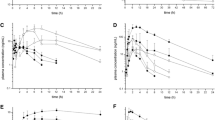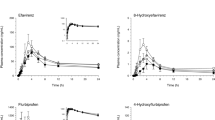Abstract
Purpose
Lansoprazole, a cytochrome P450 2C19 (CYP2C19) substrate, has been widely used in children to manage acid-related diseases. CYP2C19 exhibits marked genetic polymorphisms, and distribution of these polymorphisms varies among different ethnic groups. There is limited data regarding the use of probe drugs for determining CYP2C19 activity in children. The aim of this study was to evaluate lansoprazole as an in vivo phenotyping probe for assessing CYP2C19 activity in children.
Methods
The CYP2C19*2, *3, and *17 variants were determined in 244 children. Three hours after a single oral dose of lansoprazole (n = 94) or omeprazole (n = 19), plasma lansoprazole and 5-hydroxy lansoprazole or omeprazole and 5-hydroxy omeprazole concentrations were analyzed by high-performance liquid chromatography.
Results
The CYP2C19*17 was the most frequent variant allele (24.4%). The group of patients with CYP2C19*17*17 genotype had a 70% lower (p < 0.05) mean lansoprazole plasma concentration compared with the CYP2C19*1*1 genotype group, whereas the CYP2C19*2*2 group had 6.9-fold higher (p < 0.01) mean lansoprazole plasma concentration. Lansoprazole metabolic ratios (lansoprazole/5-hydroxy-lansoprazole) were found to be significantly lower in the *17*17 [mean ± standard deviation (SD); 2.8 ± 2.1] group and higher in the *2*2 group (63.5 ± 12.2) compared with that of the *1*1 genotype group (6.1 ± 4.5).
Conclusion
According to our results from a Turkish pediatric population, lansoprazole is a suitable probe drug for phenotyping CYP2C19. The CYP2C19*2 and *17 variants should be taken into consideration in predicting the clinical outcome of therapy with lansoprazole in the pediatric population.




Similar content being viewed by others
References
Goldstein JA (2001) Clinical relevance of genetic polymorphisms in the human CYP2C subfamily. Br J Clin Pharmacol 52:349–355
Rosemary J, Adithan C (2007) The pharmacogenetics of CYP2C9 and CYP2C19: ethnic variation and clinical significance. Curr Clin Pharmacol 2:93–109
Zhou SF, Liu JP, Chowbay B (2009) Polymorphism of human cytochrome P450 enzymes and its clinical impact. Drug Metab Rev 41:89–295
de Morais SM, Wilkinson GR, Blaisdell J, Nakamura K, Meyer UA, Goldstein JA (1994) The major genetic defect responsible for the polymorphism of S-mephenytoin metabolism in humans. J Biol Chem 269:15419–15422
Brosen K, de Morais SM, Meyer UA, Goldstein JA (1995) A multifamily study on the relationship between CYP2C19 genotype and s-mephenytoin oxidation phenotype. Pharmacogn 5:312–317
Sim SC, Risinger C, Dahl ML, Aklillu E, Christensen M, Bertilsson L, Ingelman-Sundberg M (2006) A common novel CYP2C19 gene variant causes ultrarapid drug metabolism relevant for the drug response to proton pump inhibitors and antidepressants. Clin Pharmacol Ther 79:103–113
Rudberg I, Mohebi B, Hermann M, Refsum H, Molden E (2008) Impact of the ultrarapid CYP2C19*17 allele on serum concentration of escitalopram in psychiatric patients. Clin Pharmacol Ther 83:322–327
Baldwin RM, Ohlsson S, Pedersen RS, Mwinyi J, Ingelman-Sundberg M, Eliasson E, Bertilsson L (2008) Increased omeprazole metabolism in carriers of the CYP2C19*17 allele; a pharmacokinetic study in healthy volunteers. Brit J Clin Pharm 65:767–774
Justenhoven C, Hamann U, Pierl CB, Baisch C, Harth V, Rabstein S, Spickenheuer A, Pesch B, Bruning T, Winter S, Ko YD, Brauch H (2009) CYP2C19*17 is associated with decreased breast cancer risk. Breast Cancer Res Treat 115:391–396
Ragia G, Arvanitidis KI, Tavridou A, Manolopoulos VG (2009) Need for reassessment of reported CYP2C19 allele frequencies in various populations in view of CYP2C19*17 discovery: the case of Greece. Pharmacogn 10:43–49
Gawronska-Szklarz B, Siuda A, Kurzawski M, Bielicki D, Marlicz W, Drozdzik M (2010) Effects of CYP2C19, MDR1, and interleukin 1-B gene variants on the eradication rate of Helicobacter pylori infection by triple therapy with pantoprazole, amoxicillin, and metronidazole. Eur J Clin Pharmacol 66:681–687
Sim SC, Nordin L, Andersson TM, Virding S, Olsson M, Pedersen NL, Ingelman-Sundberg M (2010) Association between CYP2C19 polymorphism and depressive symptoms. Am J Med Genet B Neuropsychiatr Genet 153B:1160–1166
Miura J, Obua C, Abbo C, Kaneko S, Tateishi T (2009) Cytochrome P450 2C19 genetic polymorphisms in Ugandans. Eur J Clin Pharmacol 65:319–320
Chen L, Qin S, Xie J, Tang J, Yang L, Shen W, Zhao X, Du J, He G, Feng G, He L, Xing Q (2008) Genetic polymorphism analysis of CYP2C19 in Chinese Han populations from different geographic areas of mainland China. Pharmacogn 9:691–702
Sugimoto K, Uno T, Yamazaki H, Tateishi T (2008) Limited frequency of the CYP2C19*17 allele and its minor role in a Japanese population. Br J Clin Pharmacol 65:437–439
Kim KA, Song WK, Park JY (2009) Association of CYP2B6, CYP3A5, and CYP2C19 genetic polymorphisms with sibutramine pharmacokinetics in healthy Korean subjects. Clin Pharmacol Ther 86:511–518
Desta Z, Modak A, Nguyen PD, Lemler SM, Kurogi Y, Li L, Flockhart DA (2009) Rapid identification of the hepatic cytochrome P450 2C19 activity using a novel and noninvasive [13C]pantoprazole breath test. J Pharmacol Exp Ther 329:297–305
Collet JP, Hulot JS, Pena A, Villard E, Esteve JB, Silvain J, Payot L, Brugier D, Cayla G, Beygui F, Bensimon G, Funck-Brentano C, Montalescot G (2009) Cytochrome P450 2C19 polymorphism in young patients treated with clopidogrel after myocardial infarction: a cohort study. Lancet 373:309–317
Streetman DS, Bertino JS Jr, Nafziger AN (2000) Phenotyping of drug-metabolizing enzymes in adults: a review of in-vivo cytochrome P450 phenotyping probes. Pharmacogn 10:187–216
Furuta T, Kodaira C, Nishino M, Yamade M, Sugimoto M, Ikuma M, Hishida A, Watanabe H, Umemura K (2009) [13C]-pantoprazole breath test to predict CYP2C19 phenotype and efficacy of a proton pump inhibitor, lansoprazole. Aliment Pharmacol Ther 30:294–300
de Wildt SN, Ito S, Koren G (2009) Challenges for drug studies in children: CYP3A phenotyping as example. Drug Discov Today 14:6–15
Rane A (1999) Phenotyping of drug metabolism in infants and children: potentials and problems. Pediatrics 104:640–643
Tran A, Rey E, Pons G, Pariente-Khayat A, D’Athis P, Sallerin V, Dupont C (2002) Pharmacokinetic-pharmacodynamic study of oral lansoprazole in children. Clin Pharmacol Ther 71:359–367
Pearce RE, Rodrigues AD, Goldstein JA, Parkinson A (1996) Identification of the human P450 enzymes involved in lansoprazole metabolism. J Pharmacol Exp Ther 277:805–816
Shi S, Klotz U (2008) Proton pump inhibitors: an update of their clinical use and pharmacokinetics. Eur J Clin Pharmacol 64:935–951
Andersson T (1996) Pharmacokinetics, metabolism and interactions of acid pump inhibitors. focus on omeprazole, lansoprazole and pantoprazole. Clin Pharmacokinet 31:9–28
Herrlin K, Massele AY, Jande M, Alm C, Tybring G, Abdi YA, Wennerholm A, Johansson I, Dahl ML, Bertilsson L, Gustafsson LL (1998) Bantu Tanzanians have a decreased capacity to metabolize omeprazole and mephenytoin in relation to their CYP2C19 genotype. Clin Pharmacol Ther 64:391–401
Laine K, Tybring G, Bertilsson L (2000) No sex-related differences but significant inhibition by oral contraceptives of CYP2C19 activity as measured by the probe drugs mephenytoin and omeprazole in healthy Swedish white subjects. Clin Pharmacol Ther 68:151–159
Goldstein JA, Blaisdell J (1996) Genetic tests which identify the principal defects in CYP2C19 responsible for the polymorphism in mephenytoin metabolism. Methods Enzymol 272:210–218
Uno T, Yasui-Furukori N, Takahata T, Sugawara K, Tateishi T (2005) Determination of lansoprazole and two of its metabolites by liquid-liquid extraction and automated column-switching high-performance liquid chromatography: application to measuring CYP2C19 activity. J Chromatogr B Analyt Technol Biomed Life Sci 816:309–314
Tamminga WJ, Wemer J, Oosterhuis B, Wieling J, Touw DJ, de Zeeuw RA, de Leij LF, Jonkman JH (2001) Mephenytoin as a probe for CYP2C19 phenotyping:effect of sample storage, intra-individual reproducibility and occurrence of adverse events. Br J Clin Pharmacol 51:471–474
Yin OQ, Tomlinson B, Chow AH, Waye MM, Chow MS (2004) Omeprazole as a CYP2C19 marker in Chinese subjects: assessment of its gene-dose effect and intrasubject variability. J Clin Pharmacol 44:582–589
Basci NE, Bozkurt A, Kortunay S, Isimer A, Sayal A, Kayaalp SO (1996) Proguanil metabolism in relation to S-mephenytoin oxidation in a Turkish population. Br J Clin Pharmacol 42:771–773
Kortunay S, Basci NE, Bozkurt A, Isimer A, Sayal A, Kayaalp SO (1997) The hydroxylation of omeprazole correlates with S-mephenytoin and proguanil metabolism. Eur J Clin Pharmacol 53:261–264
Furuta T, Kodaira C, Nishino M, Yamade M, Sugimoto M, Ikuma M, Hishida A, Watanabe H, Umemura K (2009) 13c-Pantoprazole Breath Test to Predict Cyp2c19 Phenotypes and Efficacy of Proton Pump Inhibitor. Clin Pharmacol Ther 85:S67–S67
de Vos A, van der Weide J, Loovers HM (2010) Association between CYP2C19*17 and metabolism of amitriptyline, citalopram and clomipramine in Dutch hospitalized patients. Pharmacogenomics J
Ohlsson Rosenborg S, Mwinyi J, Andersson M, Baldwin RM, Pedersen RS, Sim SC, Bertilsson L, Ingelman-Sundberg M, Eliasson E (2008) Kinetics of omeprazole and escitalopram in relation to the CYP2C19*17 allele in healthy subjects. Eur J Clin Pharmacol 64:1175–1179
Kearns GL, Leeder JS, Gaedigk A (2010) Impact of the CYP2C19*17 allele on the pharmacokinetics of omeprazole and pantoprazole in children: evidence for a differential effect. Drug Metab Dispos 38:894–897
Ramsjo M, Aklillu E, Bohman L, Ingelman-Sundberg M, Roh HK, Bertilsson L (2010) CYP2C19 activity comparison between Swedes and Koreans: effect of genotype, sex, oral contraceptive use, and smoking. Eur J Clin Pharmacol 66:871–877
Kim MJ, Nafziger AN, Zhang Y, Sellers EM, Gaedigk A, Bertino JS Jr (2004) Lack of weight-based dose dependency and intraindividual variability of omeprazole for CYP2C19 phenotyping. J Clin Pharmacol 44:966–973
Strom CM, Goos D, Crossley B, Zhang K, Buller-Burkle A, Jarvis M, Quan F, Peng M, Sun W (2011) Testing for variants in CYP2C19: population frequencies and testing experience in a clinical laboratory. Genet Med
Author information
Authors and Affiliations
Corresponding author
Rights and permissions
About this article
Cite this article
Gumus, E., Karaca, O., Babaoglu, M.O. et al. Evaluation of lansoprazole as a probe for assessing cytochrome P450 2C19 activity and genotype–phenotype correlation in childhood. Eur J Clin Pharmacol 68, 629–636 (2012). https://doi.org/10.1007/s00228-011-1151-z
Received:
Accepted:
Published:
Issue Date:
DOI: https://doi.org/10.1007/s00228-011-1151-z




